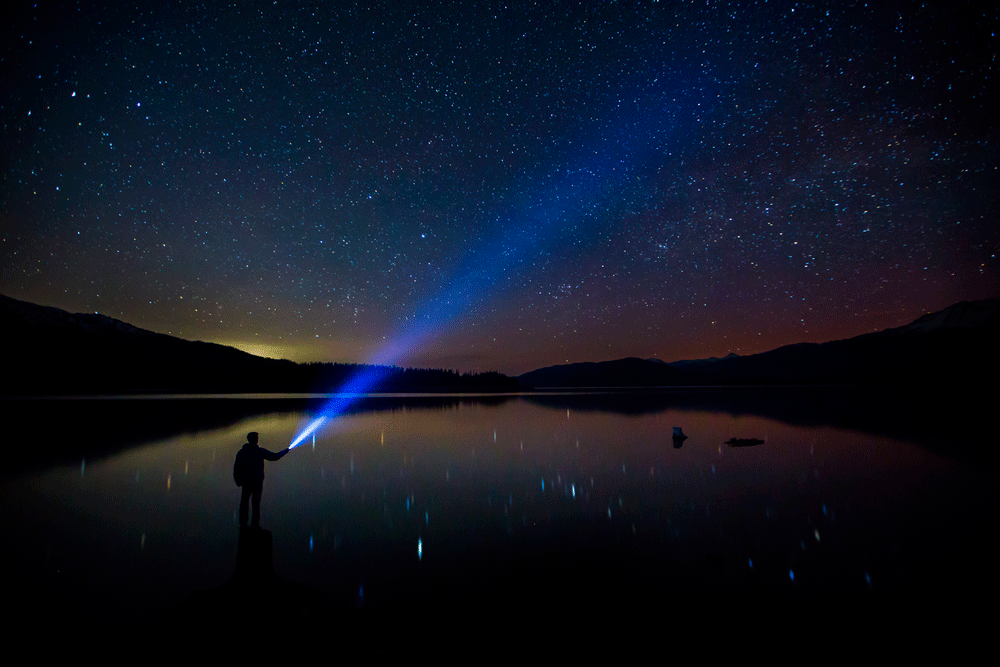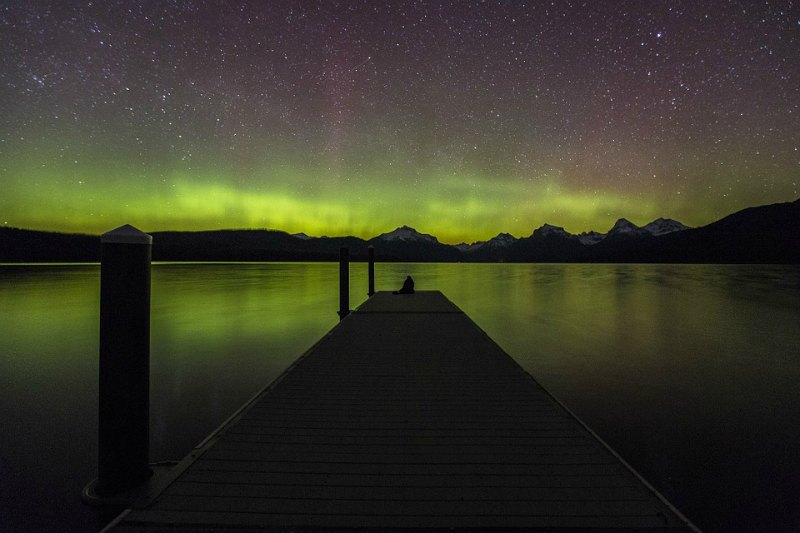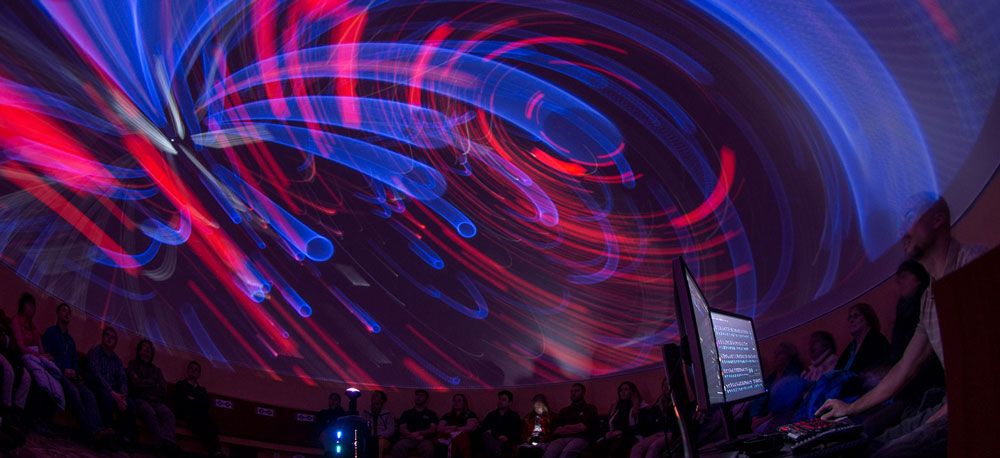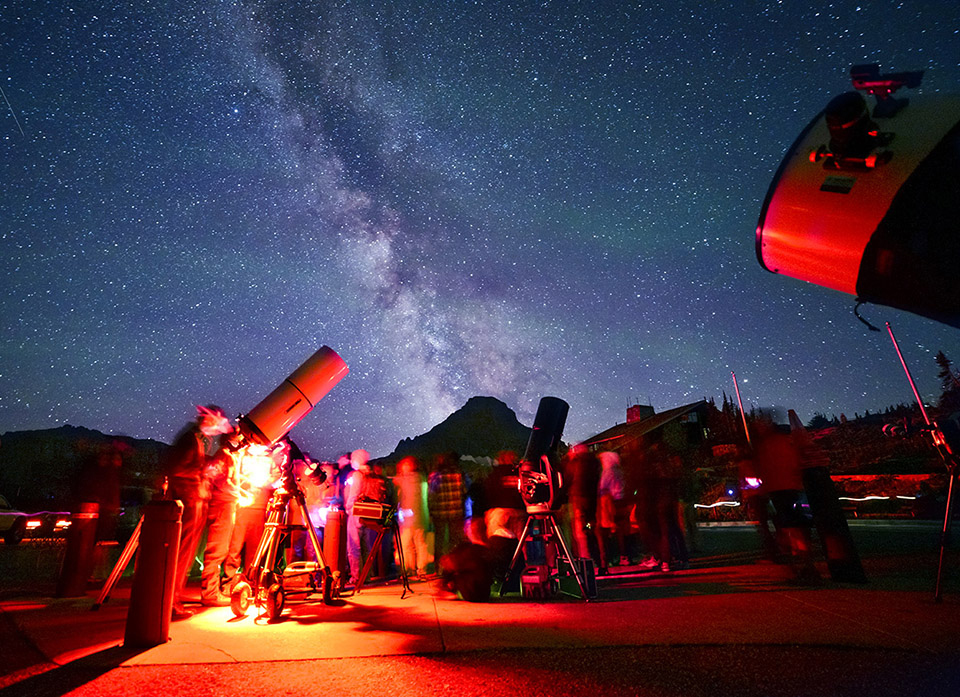As light pollution continues to increase globally, more and more travelers are seeking out locations where they can experience true, star-filled night skies. Montana’s wide-open landscapes and clear, high-altitude skies offer the perfect backdrop for stargazing. Glacier Country is one of the best places in the lower 48 to take in the stars, from spotting the Milky Way to occasionally glimpsing the northern lights. Camping under the stars, visiting one of our observatories, or aligning an itinerary with a celestial event—this is the perfect destination for groups seeking an unforgettable night sky experience.

Northern Lights
Western Montana is well-positioned for viewing one of nature’s most mesmerizing shows—the northern lights. And now’s the time. We’re in the midst of a solar maximum, a peak in the sun’s activity that brings more frequent and vivid displays of the aurora borealis. This cycle won’t peak again for another 11 years, so if catching the lights is on your bucket list, 2025 is the year.
Prime viewing areas include Glacier National Park, Lost Trail National Wildlife Refuge (a Dark Sky Sanctuary), the Northwest Corridor, the Seeley Swan Corridor and the East Glacier Corridor. While the aurora is unpredictable, here are a few tips to help increase the chances of your group spotting the northern lights:
- Download the Aurora Forecast app from the App Store to track visibility in real time.
- Take the group as far away from city light pollution as possible, find a wide-open spot and choose a clear, cold night.
- The brighter the moon, the harder it will be to see the northern lights. Check the lunar cycles and look for them during a new moon.
- The northern lights are best seen when the K-index—the level of geomagnetic activity—is high, so monitor K-index levels online.
- If you know the Aurora should be visible but can’t see it, try looking through your phone or taking a picture. A camera collects more light and is not limited by our eye’s color perception in low light.
- The northern lights are most active between September and March.

Blue Mountain Observatory
Just 45 minutes from downtown Missoula, the Blue Mountain Observatory offers groups an exceptional stargazing experience at 6,300 feet with minimal light pollution. This is an ideal stop for groups seeking a unique and educational activity. Coordinate with the observatory to participate in a public observation night, where your group can view planets, star clusters, distant galaxies, and nebulae through the observatory’s 16-inch telescope. Additional telescopes are set up outside the dome, operated by volunteer astronomers and student staff who guide the experience. Your group will also learn how to spot celestial objects using binoculars (please ask your guests to bring their own) or with the naked eye. Ensure your group comes prepared with blankets and warm layers—clear skies and unforgettable views of the Milky Way await. These are scheduled several times each summer.
Star Gazing Room: Payne Family Native American Center
For a year-round indoor stargazing experience, head to the University of Montana campus in Missoula. The Star Gazing Room at the Payne Family Native American Center offers public shows that explore constellations, planets and upcoming celestial events, along with unique topics from star lore to the evolution of our universe. Groups can schedule a private showing in advance.

Lone Pine State Park
Located southwest of Kalispell, Lone Pine State Park offers an outstanding viewpoint of the Flathead Valley. Create your own star party or join one organized by Montana State Parks and the Big Sky Astronomy Club, which includes presentations with telescope and binocular explorations of the expansive night sky.
Glacier National Park Dark Skies
Glacier National Park is one of only 26 parks worldwide to be internationally recognized as a Dark Sky Park, and the first to span an international border into the Waterton-Glacier International Peace Park. Known for its minimal light and air pollution, it offers an exceptional environment for stargazing.
For group tours visiting during the summer, the “Half the Park Happens After Dark” ranger-led viewing event is a must. These events are held from June through September at key visitor centers, including St. Mary, Logan Pass and Apgar. This unique stargazing experience allows groups to marvel at Glacier’s clear night skies, where a broad, unbroken view of the stars and Milky Way awaits. Tickets/reservations are not required.

Located at the east entrance to Glacier National Park, the Dusty Star Observatory in St. Mary is home to Montana’s largest telescope—a 20-inch scope providing high-resolution views of planets, galaxies and nebulae. For groups seeking an immersive astronomy experience, the observatory offers guided programs, where participants can enjoy exceptional views of the night sky. Additionally, for those looking for a more independent experience, the Dusty Star Observatory features an online “all-sky camera,” providing a 360-degree real-time view of the skies.
2025 Celestial Highlights
From planetary alignments to meteor showers, 2025 offers a lineup of can’t-miss celestial events. Mark your calendar—we’ll see you under the stars.
June 26: The moon and Mercury meet up, providing a glimpse of the elusive innermost planet. Mercury will be low on the western horizon after sunset; you will need binoculars or a telescope to view it.
August 12: Venus and Jupiter, two of the brightest planets, appear side by side before dawn. They may even resemble a “double planet” to the naked eye.
August 12 – 13: The Perseid meteor shower peaks. While this is one of the most anticipated showers of the year, a bright moon may limit visibility.
September 7: A total lunar eclipse—also known as a blood moon—will darken the night sky.
September 19: Moon, Venus and Regulus (the brightest star in Leo) form a celestial triangle. Look to the eastern sky just before dawn.
November 5: A supermoon known as the Beaver moon—the closest of the year—will light up the sky.
November 8: Saturn’s rings appear to vanish in an optical illusion as the planet tilts edge-on to Earth. Best viewed with a telescope in the evening sky.
December 13 – 14: The Geminid meteor shower peaks, delivering bright, frequent meteors. The best viewing is after midnight until dawn.

Things to note: Summer nights cool off in Montana after the sun sets. To thoroughly enjoy all late-night stargazing, bring necessities like warm clothes, blankets, camp chairs, headlamps or flashlights and something warm to drink. If you are looking for an amateur astronomer as a step-on-guide for your private tour, contact the local astronomy club for a night of stargazing. Please be aware they cannot conduct tours inside Glacier National Park but can find great viewing locations in the surrounding communities.
For more information on where to stay, eat and play during the day on a stargazing tour through Western Montana, please visit our Tour Operator site and specifically our suggested itineraries. If you need further information drop me a line; I’m always here to help.
Happy stargazing,
DP
June 17, 2025
Related: Canada, East Glacier Park, FIT, Flathead Lake, Glacier National Park, Group Tours, Kalispell, Missoula, Outdoor Adventure, Seeley Lake, Seeley-Swan Valley, Stargazing, Stargazing, Student tours, Tour Operator, West Glacier


Comments